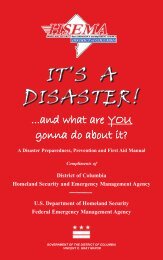disaster 5th 1108_5th ed 2011 - Homeland Security and Emergency ...
disaster 5th 1108_5th ed 2011 - Homeland Security and Emergency ...
disaster 5th 1108_5th ed 2011 - Homeland Security and Emergency ...
You also want an ePaper? Increase the reach of your titles
YUMPU automatically turns print PDFs into web optimized ePapers that Google loves.
So how do I protect myself <strong>and</strong> my family<br />
Some communities provide 2 types of shelters for local citizens, but not all<br />
cities have them plus you may not be able to get to one during a crisis.<br />
Contact your local office of emergency management <strong>and</strong> ask if they have:<br />
• blast shelter - specifically construct<strong>ed</strong> to offer some protection<br />
against blast pressure, initial radiation, heat, <strong>and</strong><br />
fire (but realize it can’t take a direct hit from a nuke)<br />
• fallout shelter - can be any protect<strong>ed</strong> space that has walls<br />
<strong>and</strong> materials thick <strong>and</strong> dense enough to absorb radiation<br />
given off by fallout. (Note: we are mainly focusing on<br />
these types of shelters in this section.)<br />
Basic shelter requirements - Whether you build a shelter in advance or<br />
throw together an exp<strong>ed</strong>ient last-minute shelter during a crisis, the area<br />
should protect you from radiation <strong>and</strong> support you for at least 2 weeks.<br />
Some basic requirements for a fallout shelter include ...<br />
• shielding<br />
• ventilation<br />
• water <strong>and</strong> food<br />
• sanitation <strong>and</strong> first aid products<br />
• radiation monitoring devices, radio, tools, firearms, etc.<br />
Shielding materials - All fallout shelters must provide good protection from<br />
radioactive particles. FEMA suggests having a minimum of several inches<br />
of concrete or 1 to 2 feet of earth as shielding around your shelter, <strong>and</strong> the<br />
more the better. Per FEMA, the following shows examples of shielding<br />
materials that equal the protection of 4 inches (10 cm) of concrete ...<br />
• 5 - 6 inches (12 - 15 cm) of bricks<br />
• 6 inches (15 cm) of s<strong>and</strong> or gravel<br />
• 7 inches (18 cm) of earth<br />
• 8 inches (20 cm) of hollow concrete block<br />
• 10 inches (25 cm) of water<br />
• 14 inches (35 cm) of books or magazines<br />
• 18 inches (46 cm) of wood<br />
Underground is best - Taking shelter in a basement or a facility below<br />
ground r<strong>ed</strong>uces exposure by 90%. Less than 4 inches (10 cm) of soil or<br />
earth can r<strong>ed</strong>uce the penetration of dangerous gamma rays by half.<br />
Prefab shelter - If you have money, time <strong>and</strong> l<strong>and</strong>, there are many types of<br />
prefabricat<strong>ed</strong> shelters you can purchase <strong>and</strong> have buri<strong>ed</strong> on your property.<br />
Some have complete living quarters <strong>and</strong> come fully stock<strong>ed</strong> with food <strong>and</strong><br />
other items. Do your research <strong>and</strong> get references first though.<br />
www.itsa<strong>disaster</strong>.net or call 1-888-999-4325<br />
115





